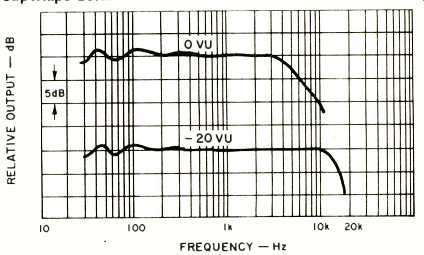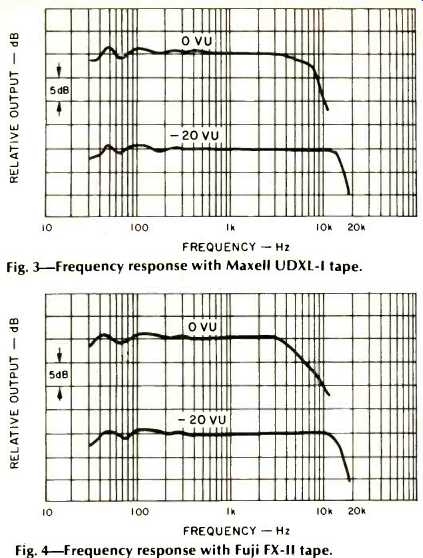
MANUFACTURER'S SPECIFICATIONS
Frequency Response: 30 Hz to 15 kHz ±3 dB, Normal; 30 Hz to 16 kHz, CrO2; and 30 Hz to 15.5 kHz, ±3 dB, FeCr.
S/N Ratio: 61 dB (weighted).
Wow & Flutter: Less than 0.06 percent W rms.
Distortion at 0 VU: Less than 0.9%.
Dimensions: 18 in. (45.7 cm) L x 10 3/4 in (25.7 cm) D x 5 1/2 in. (14 cm) H.
Price: $399.95
Radio Shack's Realistic SCT-30 is the top-line cassette deck for this enterprising company. It is a three-head machine with monitoring facilities, plus some other interesting features such as a variable-bias control and a built-in 400-Hz generator for accurate Dolby NR calibration. The cassette compartment is located on the left with the usual array of tape transport keys situated underneath. Next to them is another lever key for Eject. Then comes a group of three lever switches; the first two are three-position switches for Bias and Equalization, while the third is the Dolby NR switch.
These are followed by two pushbuttons for Tape-Source monitor and AUX-Mike input selection. Over to the right are two rotary controls; one controls the recording level, while the other is the output control. The recording control is a dual-concentric type permitting the user individual channel adjustment.
The two VU meters are located at the top of a subpanel and a peak LED indicator is situated between them. Also on the same panel is a digital counter, Record and Dolby indicators, as well as the Dolby calibration controls with a switch for the internal generator. The On/Off switch is way over on the extreme left along with the standard 1/4-in. sockets for microphones and headphones. At the rear of the deck are two Dolby calibration controls for FM recording, along with the various input/output sockets, including a DIN jack.
The record/playback heads are encapsulated into one assembly, thus preventing alignment problems. A single d.c. motor with a twin-capstan drive is used. The case is plastic while the steel cover is finished in black contrasting with the two wooden end pieces. The panel itself is made of heavy-gauge aluminum with a satin-brushed finish.
Measurements

Fig. 1--Playback response with a standard test tape.

Fig. 2--Frequency response with Radio Shack Supertape Gold.
The frequency response, measured with a standard play back test tape, was within ±1.5 dB from 40 Hz to 12 kHz as shown in Fig. 1. As the deck came with a Radio Shack premium quality Supertape Gold cassette tape, this was used for the initial record/replay measurements with the results shown in Fig. 2; the upper -3 dB frequency was at 15.6 kHz.
Next, a Maxell UDXL-1 tape was tested and the response was extended to 16 kHz. Tape number three was a Fuji FX-II chrome-substitute tape, and the high frequency response was almost identical to the Supertape Gold (see Fig. 4). Finally a FeCr cassette was checked, a Scotch Master III, and, as expected, the high end was excellent although it only beat the Maxell UDXL-I tape by a small margin-16.4 kHz against 16 kHz. The falling output at 0 VU for all four tapes is partly due to tape saturation, but the curves are somewhat steeper than usual.
How about bias control? Well, it was initially adjusted for optimum results with Supertape Gold, but it needed only a slight touch for optimum use with the other three tapes.
Figure 6 shows the distortion and headroom at 1 kHz, while Fig. 7 indicates distortion vs. frequency. Headroom be fore the 3-percent THD point is between 3 and 4 dB for all the four tapes tested with the best performance from the two standard 120 uS cassettes- Maxell UDXL-I and Supertape Gold. In terms of signal-to-noise ratio, using "A weighting and 3 percent THD, the Maxell UDXL-I and Supertape Gold measured 55 dB, while the Scotch Master Ill and the Fuji FX II were marginally superior at 56.5 dB. Switching in the Dolby NR increased these figures 9 to 10 dB.
The input required for 0 VU was 80 mV line and 0.4 mV for microphones, the output then being 700 to 800 mV depending upon the tape used. Maximum signal handling capacity for the microphone input stage was 23 mV, and the signal-to noise ratio decreased by 12 dB with the input control in its maximum position.
The Dolby system tracked very accurately, and the margin of error was within 1.5 dB down to -40 dB. Erase efficiency was over 70 dB. Wow & Flutter measured 0.05 percent (DIN 45 507), and the tape speed was less than 0.1 percent slow.
Rewind time for a C-90 cassette was 135 seconds.

Fig. 3-Frequency response with Maxell UDXL-I tape.
Fig. 4-Frequency response with Fuji FX-II tape.

Fig. 5--Frequency response with Scotch Master III FeCr tape.
Fig. 6--Distortion and headroom at 1 kHz.

Fig. 7--Distortion vs. frequency.
Listening and Use Tests
As can be seen from the foregoing measurements, the SCT 30 more than meets its specifications and is well up to the high standards for a three-head cassette deck. The dual-capstan drive helps provide a smooth tape transport, while the special attention paid to the Dolby NR requirements, such as the internal calibration generator, will appeal to many.
Those who want optimum results from various kinds of tape will certainly appreciate the variable bias facility--even though adjustments would be easier if the built-in generator could also be switched to 8 kHz or thereabouts. However, it must be said that the method recommended by Radio Shack, using FM interstation noise as a reference, worked out to be surprisingly accurate.
Overall, the Realistic SCT-30 cassette deck combines simplicity of use with enough versatility to appeal to amateur and audiophile alike, a very good value for the money.
-George W. Tillett
(Adaped from Audio magazine, Jun. 1979)
Also see:
Realistic (Radio Shack) Model STA-225 AM/FM Stereo Receiver (Equip. Profile, Dec. 1975)
Realistic (Radio Shack) STA-120B AM /Stereo FM Receiver (Dec. 1972)
= = = =